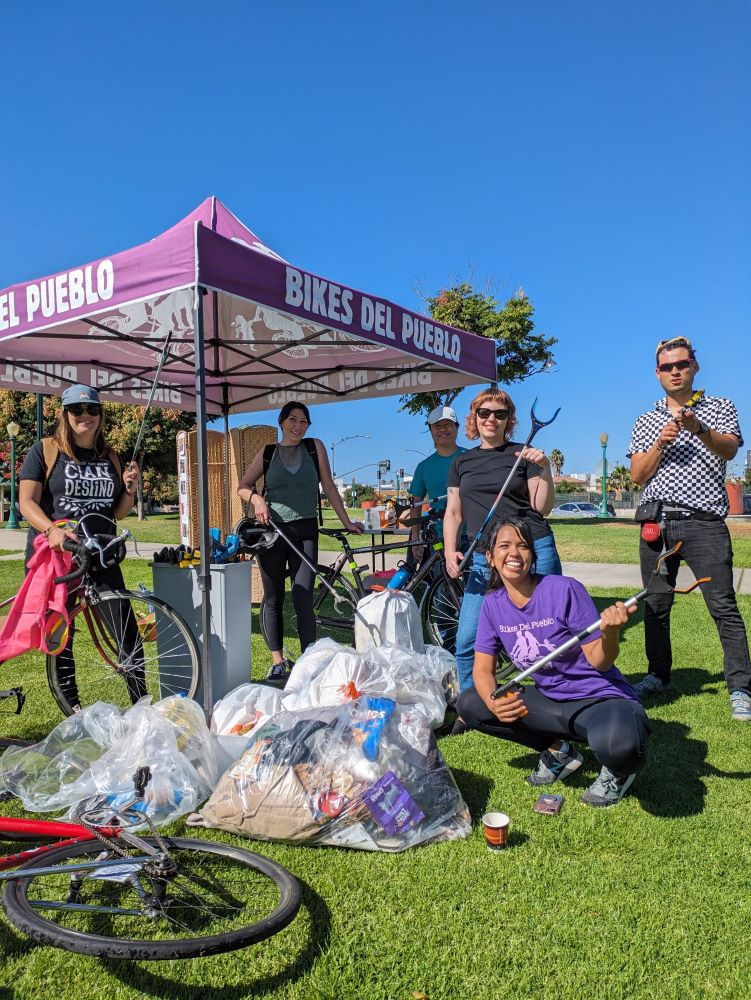Inclusive Engagement Techniques and Approaches
Engagement through Service

What is it?
Engagements through service are public engagement efforts where staff and any partners collaboratively contribute to projects by providing a service or enhancing the community. This technique can be used to gather public input while also engaging community members in hands-on activities that improve local conditions. This technique can help motivate people to share their input on long-range planning or other project concepts that may seem intangible. The service activities can show community members how City policies can positively impact their communities.
When to use it
Engagement through service supports public engagement with a direct, visible community impact. It is ideal for projects such as public space improvements and those at the involve or collaborate levels of engagement, offering a tangible way to build relationships, gather feedback and foster a sense of ownership among participants. Some examples of engagement through service include:
- Climate Resilient SD Living Wall. The City Planning Department partnered with the Copley-Price YMCA to build a living wall. Dozens of youth campers from the YMCA helped create the wall, which holds a variety of plants and succulents, to help remove air pollutants and reduce urban heat for years to come. Youth campers were also invited to participate in a sticker poll to help inform the plan. This project was part of the City’s development of Climate Resilient SD, a plan to prepare for climate change and build greener, safer and more sustainable communities.
- Community Clean Up. The City Planning Department partnered with community-based organization Casa Familiar to host a community clean-up of a highway overpass that doubles as a pedestrian bridge in the San Ysidro area. The event was an opportunity to discuss environmental justice priorities as community members came together to improve their community’s cleanliness. This event was part of the development of the City’s Environmental Justice Element, which provides policies for the advancement of equitable, healthy and livable communities for all San Diegans.
How to do it
Before
- Partner with community leaders and local organizations to identify a service and coordinate a service project that addresses a local need.
- Collaborate with local organizations to recruit participants and leverage existing networks.
- Conduct outreach to encourage participation as needed, such as using email notifications, flyers or social media.
- In addition to standard outreach channels, directly contact organizations and people that may have interest in participating.
- Check weather conditions in advance of the service event.
- Remind staff to dress accordingly.
- If temperatures of 80°F or higher are anticipated, ensure water and shade are available and/or consider postponing the service event.
During
- Develop a clear service project plan and share with any community partners, including materials, timeline, maintenance strategies and desired outcomes.
- Determine if any permits are needed.
- Provide a sign-in sheet to collect optional contact information of attendees to share ongoing project updates.
- Share information with community members about the project topic and incorporate an engagement activity within the event and/or make them aware of avenues for future input (e.g. project-specific groups, workshops).
- Document the project's impact through photos, videos and participant quotes.
After
- Collect and analyze any feedback from participants.
- Share the outcomes and impacts of the project with the community through techniques such as newsletters, social media updates and briefings to maintain transparency and encourage ongoing engagement.
Resource considerations
![]()
Cost: Minimal to High
Costs can vary significantly based on the scale and complexity of the service project. Simple, small-scale activities, like a community cleanup, can be inexpensive, while more complex activities that necessitate planning, design, construction and/or maintenance may require more significant investments.
![]()
Time: Minimal to High
The time required to plan and implement service projects depends on their scope and detail. Engagement through service may take under a month or up to several months to plan and implement.
![]()
Capacity: Moderate to High
The capacity needed for service projects varies with their complexity. A few staff may be needed to plan and implement a simple service project, but a team may be needed for a complex service project.
Other considerations
- For outdoor projects, check weather conditions in advance of the event.
- Remind team members to dress accordingly.
- If temperatures at 80°F or higher are anticipated, ensure water and shade are available and/or consider postponing the event.
- Obtain necessary permits, licenses or approvals from relevant City departments or other authorities and consider any legal implications or liabilities associated with the project, such as insurance requirements or waivers.
- Identify ongoing community involvement and stewardship opportunities, such as regular maintenance or programming related to the service project's outcomes.
How to make it more inclusive
- Choose venues that are fully accessible, including parking, entrances and restrooms. Choose venues near transit and that have adequate parking.
- Incorporate cultural traditions, practices or art forms into the project to celebrate the community and foster a sense of pride and ownership among participants.
- Identify any language interpretation needs in advance.
- Consider providing participation support.
Inclusive Engagement Techniques and Approaches
- Introduction
- Appreciative Inquiry
- Arts-based Engagement
- Briefings
- Comment Forms
- Community Cafés
- Community Mapping
- Community Office Hours
- Email Notifications
- Engagement through Service
- Fact Sheets
- Flyers
- Focus Groups
- Game-based Approaches
- Hotlines
- Information Kiosks
- Interviews
- Meeting in a Box
- Mobile Engagement
- News Releases
- Newsletters
- Open Houses
- Participation Support
- Pop-Up Events
- Project Models
- Project-specific Groups
- Public Meetings
- Public Service Announcements (PSAs)
- Social Media
- Surveys and Polls
- Tours and Field Trips
- TV/Radio/Podcast Interviews
- Vision Walls
- Web-Based/Hybrid Meetings
- Webpages
- Workshops


 Inclusive Public Engagement Guide
Inclusive Public Engagement Guide